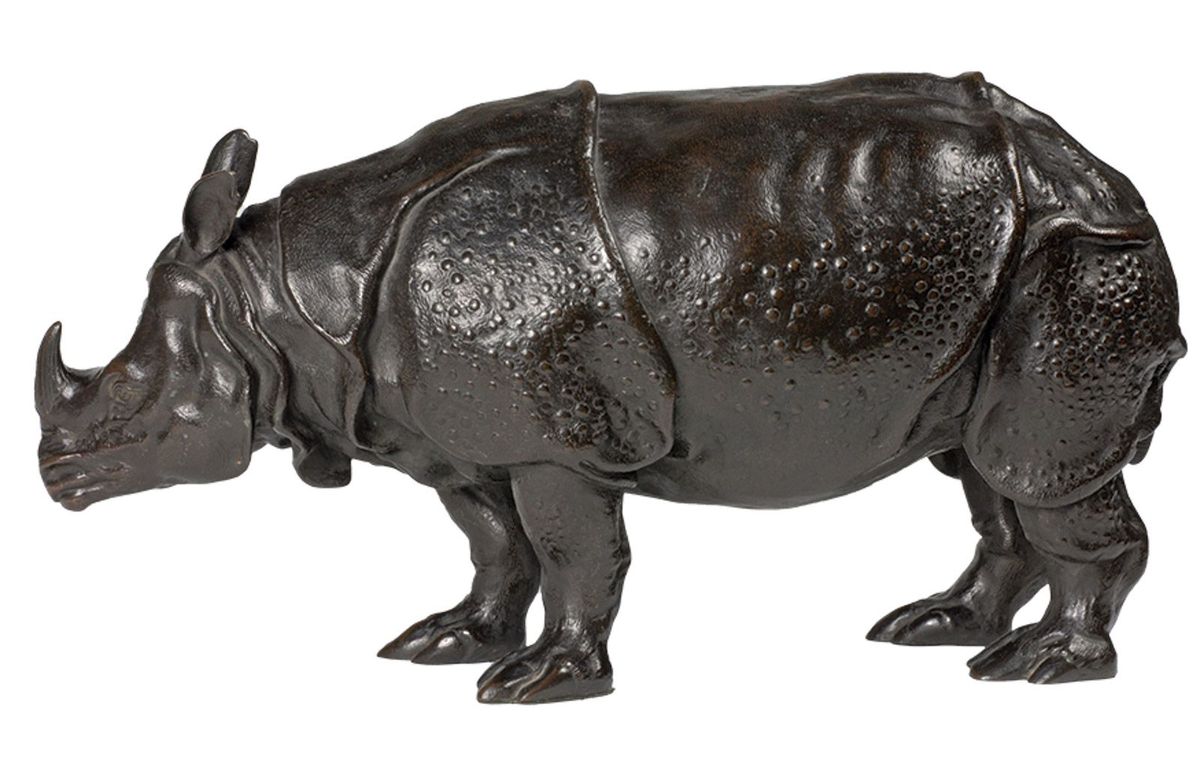William Hogarth, legendary friend of pugs, had a thing or two to say about mankind’s abuse of animals. His 1751 print series The Four Stages of Cruelty starts with the child Tom Nero torturing a dog, followed by the adult Nero beating a horse, which leads inevitably (Hogarth suggests) to the murder of his pregnant partner, and concludes with the state-sanctioned cruelty of public execution and the anatomising of Nero’s screaming corpse by indifferent surgeons.
Hogarth may have joined the hordes that visited the exhibition of the Indian rhinoceros (rhinoceros unicornis) “Miss Clara” during her grand tour—a punishing 17 years criss-crossing Europe from Leiden to Copenhagen and Warsaw, to Naples, Marseilles and Paris (etc, etc) and back again, several times. She was in London for the third occasion in 1758 when she died, “unexpectedly”. The entrepreneurial skills of the Dutch sea-captain Douwe Mout van der Meer, who had bought her as a calf, transformed a rare rather than unique appearance of a rhinoceros in Europe into the fashionable attraction of the age, indicated by the fact that she, rather than previous animals, had been given a name, and the many ways through which she was commemorated, including portraits in oil, bronze and ceramic.
If Hogarth, a feeling chap, had witnessed this at once majestic, extraordinary, weary and lonely creature, surely he would have been stirred to sympathy as well as a sense of wonder: a reaction likely to be replicated by readers of this visually rich and thought-provoking catalogue, as well as the visitors to what promises to be an equally beautiful and stimulating exhibition at the Barber Institute of Fine Arts in Birmingham, UK. Mankind’s collective negative environmental impact is unequivocal, as is the extreme imbalance between over-consuming, resource-guzzling regions and the rest (whether human, animal, insect, plant) who share the planet with us. Addressing this, as well as the historical context, the director of the Barber Institute, Nicola Kalinsky, observes in her introduction that Clara is here “considered both as a subject in art and as a sentient being, an individual creature whose spectacular and sad life illuminates both interspecies relations and societal impacts from contacts between the West and the wider world.”
Miss Clara and the Celebrity Beast in Art takes the Barber Institute’s popular exhibit, a bronze sculpture (around 1770) after Peter Anton von Verschaffelt, as the starting point for a broader exploration of how Clara and other “fabulous” exotic beasts—particularly elephants and hippopotami—were brought to Europe for entertainment and study. Three in-depth essays by the exhibition curator Robert Wenley (Clara and other celebrity beasts), Charles Avery (representations of elephants from the renaissance to the baroque) and Samuel Shaw (exotic animals in 19th-century private menageries and public zoos) are followed by catalogue entries for exhibits covering a wide range of object-types and media.
The rhinoceros population in the wild was 500,000 at the beginning of the 20th century. It is now just 27,000 due to poaching and habitat loss, with the black, Javan and Sumatran species critically endangered. Yet for Clara’s successors there is some hope. According to the World Wildlife Fund, conservation efforts have increased Indian rhinoceros numbers from around 200 to 3,700 over the same period. This exhibition and catalogue, while celebrating the skill of artists and artisans, does not ignore the exploitative practices of previous centuries, reminding us of the urgency for action in the 21st.
Miss Clara and the Celebrity Beast in Art 1500-1860, Robert Wenley (ed), with contributions by Robert Wenley, Charles Avery, Samuel Shaw and Helen Cowie, The Barber Institute of Fine Arts/Paul Holberton, 96pp, £16.50 (pb), published 12 November
• Miss Clara and the Celebrity Beast in Art, The Barber Institute of Fine Arts, Birmingham, 12 November–27 February 2022
• Jacqueline Riding is contributing editor, books for The Art Newspaper and author of Hogarth: Life in Progress (Profile Books 2021)


